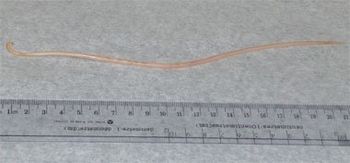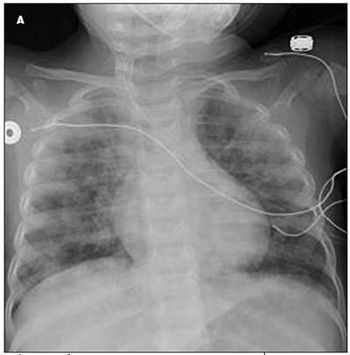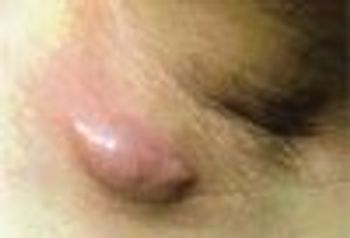
A significant number of patients with cancer are parents of children under 18 years of age.

A significant number of patients with cancer are parents of children under 18 years of age.

Childhood immunizations are one of the most successful public health interventions of all time.

Popular household name drugs, including Tylenol, Motrin, and St. Joseph's Aspirin, were recalled by New Brunswick, New Jersey-based Johnson & Johnson in mid-January because of a moldy smell associated with the drugs.

Children who get cochlear implants in both ears eventually can manage the loudness and pitch of their voices, according to a new study.

Investigators at a hospital in Alberta, Canada, planned to determine the effect of immunoglobulin A endomysial antibody (IgA-EMA) testing on the incidence and clinical presentation of childhood celiac disease.

An analysis of data from the National Infant Sleep Position Study, an annual national telephone survey of about 1,000 caretakers of infants aged up to 7 months, shows that from 1993 to 2001, supine sleep increased for all infants.

Children with attention deficit hyperactivity disorder (ADHD) may have failures in certain brain connections that occur when children attempt tasks requiring their attention.

Sleep issues may be more prevalent in children who have asthma and who also have exposure to secondhand smoke (SHS), according to new journal research.

When the medical diagnosis of "concussion" is given to explain injuries in children, it may be misleading to parents and physicians, causing them not to realize the potential severity of brain injuries in children, according to a study published in Pediatrics.

High lipid levels may be a common theme among 20% of US children and teenagers, as reflected by high low-density lipoprotein (LDL) cholesterol levels, low high-density lipoprotein (HDL) cholesterol levels, or high triglycerides, according to the CDC.

A recent study suggests that a child's risk for arterial ischemic stroke (AIS) or cerebral sinovenous thromboembolism (CSVT) is related to endogenous testosterone concentrations.

More young children between the ages of 2 and 5 years are being diagnosed with bipolar disorder and receiving antipsychotic drugs compared with 10 years ago.

An editorial that examines the link between receipt of the combined measles, mumps, and rubella (MMR) vaccine and the development of autism, in the wake of a recent journal retraction.

Novartis has introduced a vaccine additive that is designed to enhance immune response to various viruses.

An examination of the charts of 244 children evaluated for physical abuse in an urban hospital showed that about one-fifth of the patients had 1 or more screening tests for occult abdominal trauma.

The United States is to conduct new research into the potential health effects of the plastics chemical bisphenol A (BPA), which had been used in baby bottles and other food and beverage containers, according to health officials

Nurture, Inc, prompted by the FDA, has alerted healthcare providers to a voluntary recall of specific varieties and date codes of Happytot Stage 4 and Happybaby Stage 1 and Stage 2 pouch meals with expiration dates between November 2010 and January 2011.

The entire series of pentavalent rotavirus vaccine (RV5) may be highly effective in responding to severe rotavirus acute gastroenteritis (AGE).

A mother seeks an evaluation of her 20-month-old son, who has grown slowly and has had leathery dry skin since birth. He also has had multiple skin infections and chronic conjunctivitis, and he has delayed language development.

Given that college athletes are up to half as likely as their peers to smoke cigarettes, investigators explored whether varsity, club, and intramural athletes also are less likely than nonathletes to engage in waterpipe smoking

Through an intense process, a subcommittee advising the federal government has selected 24 areas by which to measure healthcare quality for children covered by Medicaid and the Children's Health Insurance Program.

A healthy 4-year-old girl passed a threadlike object in her stool at a day-care center. She had no diarrhea, vomiting, or abdominal pain. Stool had no blood or melena. Child’s appetite normal.

The authors’ comments on the use of melatonin to treat insomnia in children were very helpful as well.

To determine which children who had sustained head injuries would not benefit from CT scans, Kuppermann and colleagues3 conducted a prospective cohort study of more than 42,000 children from 25 North American emergency departments (EDs).

am writing in reference to “Diagnostic Challenges Associated With Pediatric Tuberculosis: 2 Cases,” (Consultant For Pediatricians, August 2009, page 300). At our pediatric TB Clinic, we try to counteract the various “urban myths” about TB that have been inculcated into the residents on their other rotations. We also provide our residents with hopefully a better understanding of the pathophysiology of TB in children so that they can make more educated risk/benefit decisions about the workup and treatment of patients.

Every year, in the weeks beforeChristmas, there is atleast one television stationairing the movie “It’s aWonderful Life.” Watchingthis 1946 film has become an annualritual for me.

My daughter has been overweight her whole lifeand is always the largest kid in class. She’s juststarted high school and wants so badly to feelattractive, yet she cannot bear trying anotherweight loss program. At 5 ft 6 in, she weighs262 lb. Can you refer her to a surgeon so she canhave the operation that helps her lose weight?

The areas of hyperpigmentation shown here on the trunk of a 15-year-old girl appeared 2 years earlier as 1- to 2-mm hyperpigmented papules with either flat or verrucous surfaces.

A 16-month-old girl was initially brought to her primary care physician because of persistent nonproductive cough of 1 to 2 weeks’ duration, with lethargy, poor feeding, and worsening cough for the past 36 hours. She had been afebrile. The patient was noted to be pale and had a decreased level of interaction. She was promptly sent to the local emergency department. Laboratory studies showed a hemoglobin level of 3.8 g/dL and hypochromic microcytic anemia. The patient was subsequently transferred to the pediatric ICU for evaluation.

An overweight 13-year-old girl, with a body mass index of 29, presented with a lump in her axilla for the fourth time in the past several months. This time, the lump recurred in the left axilla; it had developed in the right axilla on 2 other occasions.